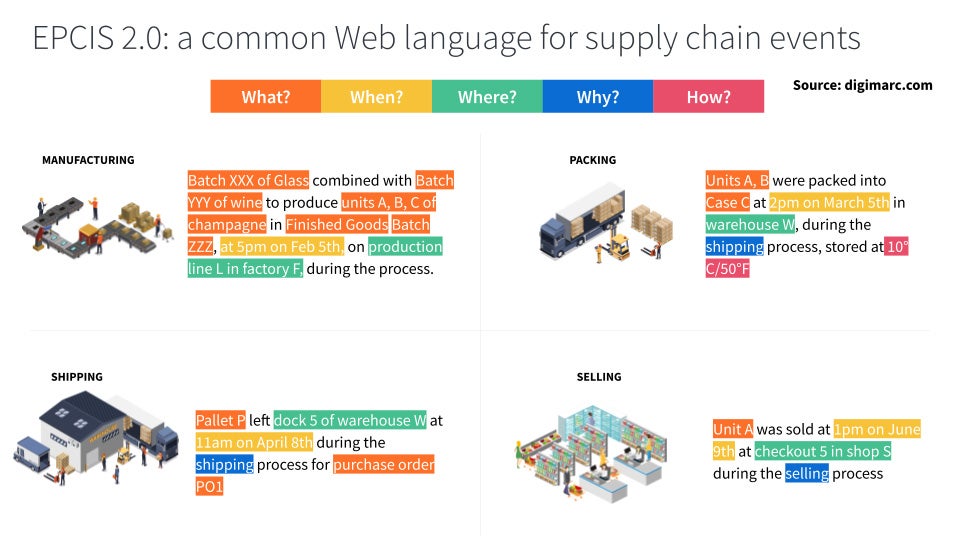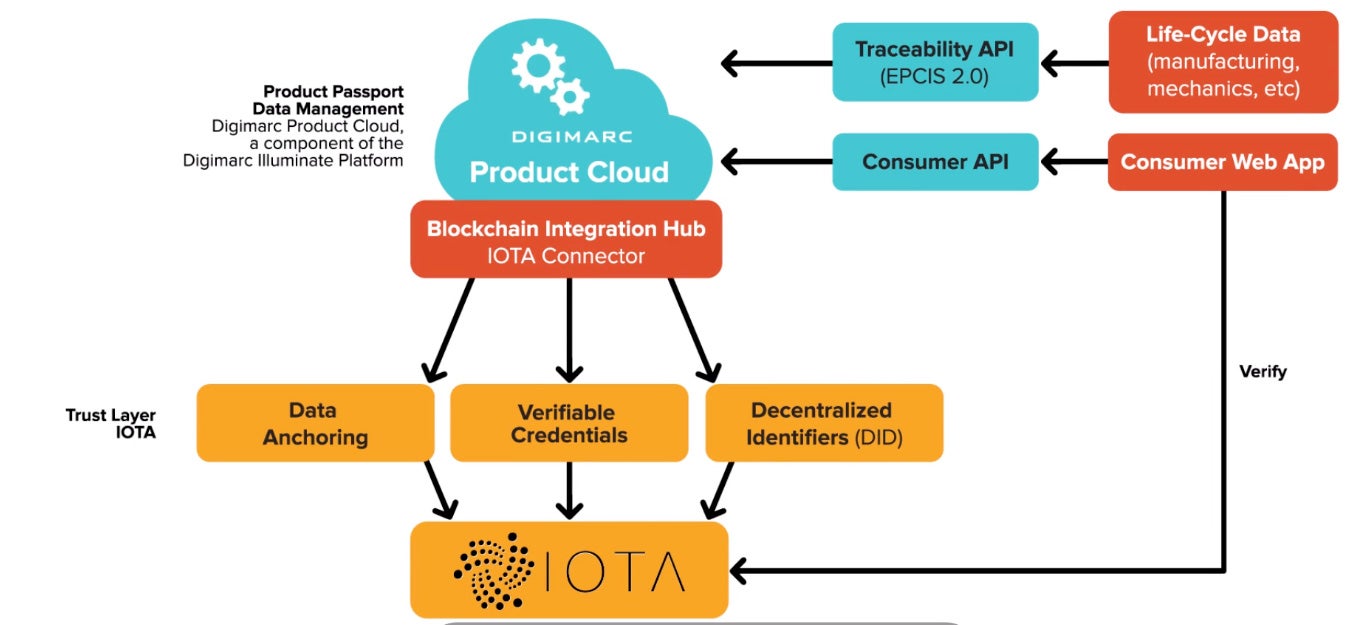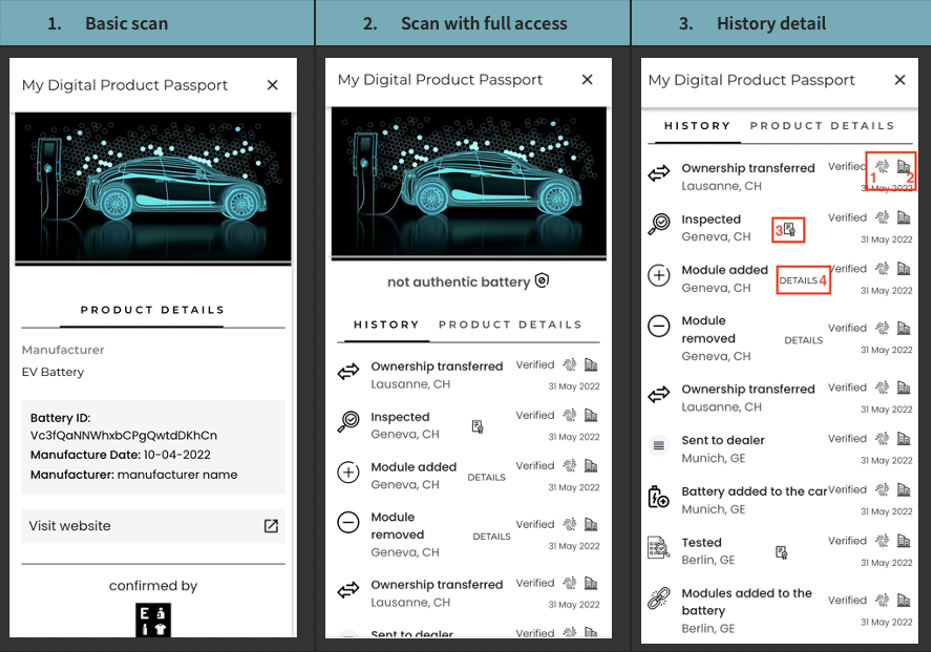The Digital Product Passport EU initiative will require many products to feature a unique Digital Passport that enables products to be tagged, identified, and linked to data relevant to their circularity and sustainability. It will allow tracking the origin of components and raw materials used in all kinds of consumer goods and to electronically share information about the environmental impact of the different stages of the supply chain across the product life cycle. This will help consumers make greener choices and will help companies leverage new business opportunities that improve the environmental performance of products and encourage a more circular economy.
Digimarc and IOTA collaborated on a project to create a Digital Product Passport blueprint in support of some of the EU initiative requirements including the use of open standards, decentralized architectures, and accessibility. This Digital Product Passport blueprint was recently tested in a pilot project to provide electric vehicle batteries with Digital Product Passports.
The European Commission announced at the end of March 2022 its intention to make Digital Products Passports mandatory as soon as 2024 at least for all product categories regulated under the Ecodesign for Sustainable Products Regulation. Additional delegated acts issued by the EU specify the Digital Product Passport requirements for specific product categories (e.g. starting with Electric Vehicle batteries, textiles, construction materials, consumer electronics, packaging, food). The aim of these passports is to track, process, and share information to make consumer products longer-lasting, easier to repair and recycle, and cleaner in terms of usage of environmentally-friendly materials, enhancing the overall environmental sustainability of products placed on the European market.
At Digimarc, we strongly support the systemic tracking of products in order to enable efficient recall of products, offer new opportunities for the repair, refurbishing, reuse or recycling, and, ultimately, to achieve deep insights on the lifecycle of the products.
While the exact list of products and standards have not been set yet, the regulation already establishes the key overarching principles that DPP will have to meet. This includes:
The use of open standards and fully interoperable formats throughout end-to-end communication and data transfer
Unique and persistent identifiers specific to a product, which will be stored in a product passport registry at EU level to enable enforcement of environmental product requirements by public authorities across Europe.
The system should be easily accessible. Consumers, economic operators, and other relevant actors shall have free access to the product passport based on their respective access rights set out in the applicable delegated act. The rights to access and to introduce, modify or update information in product passports shall be restricted based on the access rights specified in delegated acts.
The DPP should be based on a decentralized data system that is set up and maintained by the economic operators that handle the data related to the product along its lifecycle. The brands placing the product on the market are responsible for making available the DPP, either directly or by authorizing another data operator to do this on their behalf. Every other operator along the lifecycle that performs a new operation on the product (e.g. distributing, repairing, recycling, reusing, destroying the product) is responsible for updating the DPP.
Passports shall be designed and operated to ensure a high-level of security and privacy. Data authentication, reliability and integrity shall be ensured.
Digimarc and IOTA have been following the DPP initiative since its inception as our expertise and experience deploying identities and digital twin profiles for billions of consumer products is well aligned with the DPPs goals. We collaborated to create a Digital Product Passport blueprint in support of some of the EU initiative requirements including the use of open standards, accessibility, and decentralized architectures. This blueprint was recently tested in a pilot project to provide electric vehicle batteries with Digital Product Passports.
We are actively monitoring the forthcoming standards to be adopted this year to provide tailor-made DPPs for the selected product categories by 2024.
Recently, we had the chance to work on a concrete project with the IOTA Foundation for the European Commission to create a blueprint for future Digital Product Passports. The blueprint was developed in conjunction with the EU Blockchain Pre-Commercial Procurement Project – an EU project to develop the European Blockchain Service Infrastructure (EBSI) that will be used for many use cases that provide cross-border services to European citizens and businesses.
We took on the challenge to create and implement a DPP architecture that respects the early design criteria of the EU DPP Initiative.
The use of standards was a top priority and we had two design criteria at the heart of the DPP initiative to meet: providing open and interoperable identities and making those identities accessible to most consumers. We quickly determined that the GS1 Digital Link standard we helped develop in 2018 is the clear choice as it defines unique web addresses for products that can be used in many types of carriers (e.g. QR codes, NFC tags) and can be read by many different readers, including smartphones used by consumers around the world.

The lifecycle data is captured using EPCIS 2.0, a standard we helped develop to be the lingua-franca of supply chains. EPCIS allows all events to be captured and queried in a standard and web compatible format and its deployments typically consist of sets of decentralized servers called repositories.
To allow for deeper decentralization and resilience, the architecture we developed with IOTA includes a Decentralized Ledger Technology (DLT) layer that we use as a trust layer to store important lifecycle events and anchor all supply chain events in the EPCIS format. This ensures events are not tampered with by putting a fingerprint (hash) of the events onto a decentralized ledger.

When looking at implementing the blueprint, IOTA’s and Digimarc’s roles are clear. The Digimarc Illuminate Platform is used to generate GS1 Digital Link identities at-scale. The product lifecycle data is ingested via our beta EPCIS 2.0 API and each event is then anchored to the IOTA DLT via Digimarc’s Blockchain Integration Hub, ensuring the data is secure. We used IOTA’s implementation of the Decentralized Identifiers (DID) and Verifiable Credentials, a set W3C standard recommendation that allows digital signing transactions on a blockchain. In short, it identifies the author of an event (via a DID) in order to ensure the person or entity is 1) authorized, and 2) competent to perform the specific event. For example, it could be used to certify that the cotton used to produce a garment was indeed organic.
Finally, we incorporated Digimarc Engage to redirect users to the correct experience. Whether it is a product authenticity check for a brand inspector (via Digimarc Validate), a user-friendly rendering of EPCIS events showing consumers the product lifecycle or provenance data, or giving consumers specific recycling instructions directly through the product item, all of the events and signatures are checked automatically by the web application which uses an SDK to compare data stored in the Illuminate Platform with anchors (hashes) and signatures on IOTA’s DTL platform.

As a part of the EU blockchain PCP project, we tested the implementation of this DPP blueprint with electric vehicle batteries, one of the prioritized product categories from the framework. As shown below, several steps in the production and maintenance of the battery and its modules were tracked by a mix of stakeholders who digitally signed the events they recorded. For instance, a mechanic performing a battery module replacement recorded the event via the mobile web app after logging in and scanning the battery and module unique code.

The owner of a battery scans the unique code – or the digital identity – on the battery to retrieve a full digital profile of the battery, including the material composition, care instructions, an overview of the maintenance performed, and the identity and certifications of those who performed maintenance.

You can see a lot more details about the app and the experience by watching the video at the top of this post.
Digital Product Passports and target markets are still being defined. Even so, the direction the EU is taking on circularity is becoming clearer, and the target deadlines growing nearer. 2023 will be a pivotal year for the DPP as stakeholders will write regulations, propose architectures, and launch real-world pilots.
Digimarc and IOTA are happy to have the opportunity to help pave the way, proposing early pilots and implementations that will eventually become a product in market. The DPP will certainly be one of the most significant pushes for accelerating the use of digital product identities in the coming years, alongside powerful industry initiatives like Sunrise 2027 -- moving 1D barcodes to 2D (e.g. QR codes) allowing for more capacity, serialization, and direct consumer interactions. It’s time for brands to embrace digital product identities with the knowledge that Digital Product Passports are on the near horizon. Beyond new regulations, brands will benefit from the transparency created as consumers demand greater sustainability and durability. DPPs allow brands to demonstrate their sustainability leadership.
Note: Part of this work was performed by the IOTA Foundation and Digimarc as participating contractors in the European Blockchain Pre-Commercial Procurement under Framework Contract nºFW-00110980.
